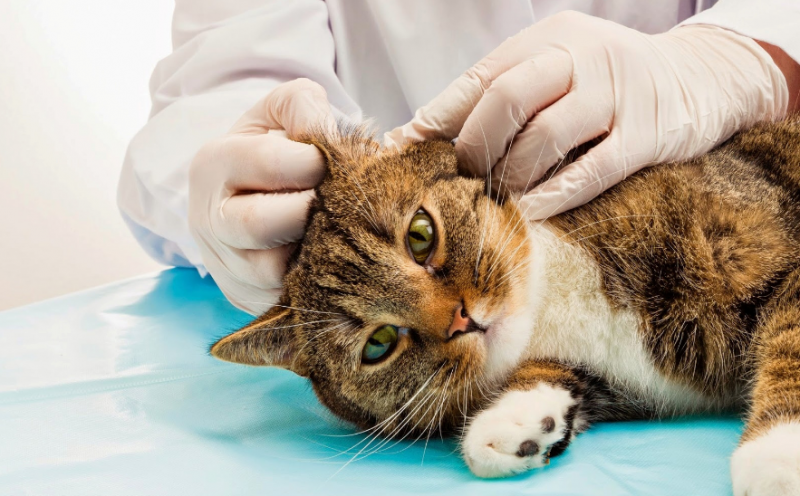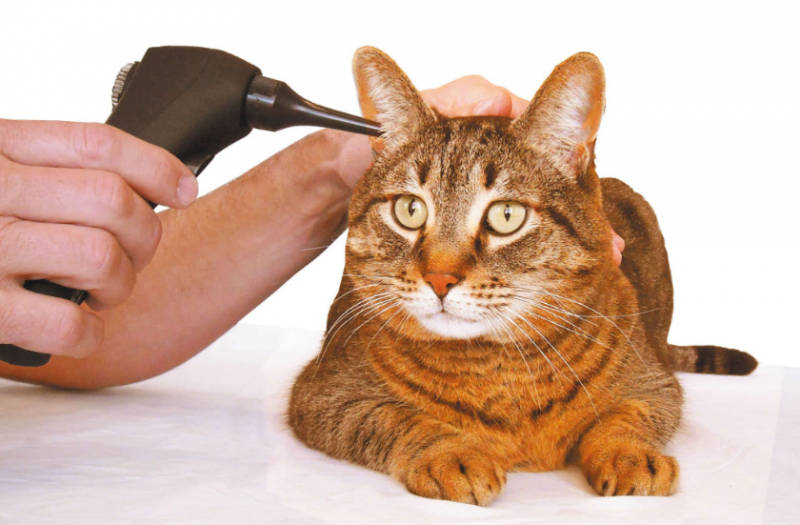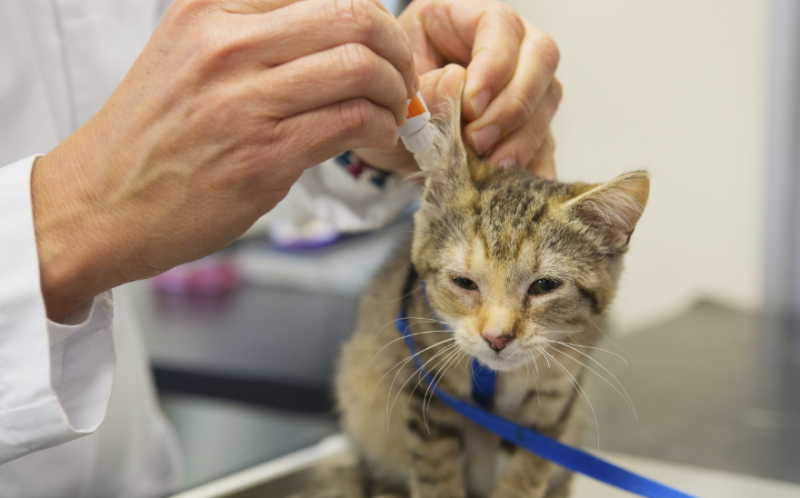Throughout the life of pets, their owners often encounter numerous diseases of pets. One of the most common and dangerous diseases is the ear tick in cats. What threatens this ailment to four-legged pussies and how to rid the animal of unpleasant symptoms?
Material Content:
What is otodectosis in cats
Ear mite (Otodectos cynotis) - a microscopic organism, the size of which does not exceed 0.7 mm.
The color of his body is pale yellow, the limbs, in relation to the body, are long. It is possible to consider how a tick looks only with the use of special optics.
It is interesting. Being a small arthropod, an ear mite, in fact, is a relative of spiders.
Microorganisms multiply in the moist heat of the ears of animals. Hiding in the auricle, these parasites provoke the release of earwax, which causes irritation and inflammation of the hearing organ. Also, this creature is able to reduce the protective reaction of the animal organism, gradually affecting the internal organs and skin integuments. The parasite provokes the so-called ear scabies, or otodectosis. An alternative name is acariasis.
Usually a microorganism affects both ears at once, feeding on the internal epidermis - the smallest scales of the skin.
Often, cats become infected with a tick during direct contact with their peers or mother. It is interesting that young cats are most often sick, among mature individuals otodectosis is much less common. Some literature claims that ticks can carry fleas or flies. In such cases, even domestic animals that do not leave the home are susceptible to infection.
Note.Adult ear mites do not differ in survivability and, falling outside the auricle, die. However, they are able to survive at a temperature of 4 - 7 ° C for several more weeks.
Features of the disease
Eating the cells of the surface layers of the skin, ear mites irritate them and injure them, causing swelling and an increase in the body temperature of the animal. Exudate begins to ooze from the damaged integument, which, when dried, combines with the mite's vital products and forms brownish fetid scabs. Such crusts form a plug in the inside of the ear canal.
The lack of timely diagnosis and treatment often leads to various negative consequences: inflammation of the lymph nodes, deafness, central nervous system damage, and sometimes pet death.
Is it transmitted to humans
Among the diseases that animals are susceptible to, there are those that are transmitted to humans. But otodectosis is not one of them. An ear mite that infects animals is not transmitted to humans.
Some species of ear mites can also affect humans. Often, tourists who come from exotic countries are considered to be their carriers. But even there, these microorganisms have nothing to do with animals, only humans. But the scabies mite is able to infect humans and animals alike.
Symptoms of an ear tick
The basic sign by which it is possible to recognize the presence of a parasite in cats is purulent discharge from the ear of a pet.
Also, upon careful consideration, additional signs can be noted:
- ear pruritus;
- hyperthermia;
- loss of appetite;
- hearing impairment;
- repulsive smell coming from the ears.
The lack of timely therapy can lead to inflammation of the meninges of the animal. The most serious disease is marked by hyperthermia. The four-legged may have a crooked head - the animal will move, tilting its head in the direction of the ear that bothers it. Nervous seizures can occur, after which the pet usually dies.
Diagnosis and treatment of otodectosis
If the owner has found black dirt in the cat’s ear, a veterinarian should be visited.
Attention! Only the specialist in the veterinary clinic laboratory can diagnose otodectosis with accuracy.
It is forbidden to make an independent decision about treatment methods before receiving test results. Having confirmed the diagnosis based on laboratory tests, the specialist prescribes a course of therapy.
Treatment of otodectosis in cats usually involves the use of the following medications:
- Drops from an ear tick. Many of them contain antibiotics that are detrimental to various infections, as well as adult ear mites. For drip therapy prescribed "Bars", "Tsipam" and so on. In order not to cause an animal protest during the ear treatment procedure, the drops should be slightly warmed up. Revolution for Cats is recognized as another effective drip. This tool is drip applied to the withers, and after absorption into the blood, it acts on ticks and fleas. These drops are often used to prevent the appearance of various parasites on cats.
- Ointments / aerosols. The most popular example of such drugs is the Aversectin ointment, applied to the patient’s ear with a special spatula. It is also permissible to use a swab dipped in ointment, treating the animal’s ear twice a day for 5 days. No less effective spray "Acaromectin", which is evenly sprayed on the ear surface. With the permission of the doctor, it is permissible to use the preparations "Stronhold", "Oridermil", "Frontline".
Before using any medicine, the auricle of the four-legged should be cleaned of pus and dried scabs.
This is best done with a swab soaked in hydrogen peroxide / special lotion. When the pollution becomes sour, the cat herself will shake off the ticks, or the owner will remove their remains with a cotton swab.
When the medicine has been applied, the animal’s ear should be massaged near the base.
Attention! It is necessary to bury funds in strict accordance with the instructions, observing the dosage until the animal is completely cured.
Alternative methods of eliminating the ear tick at home:
- Green tea. 1 tbsp. l raw materials pour a glass of boiling water and insist 5 minutes. The cooled solution is pipetted into each ear of a sick animal.
- Garlic. Before use, several peeled cloves should be insisted on any vegetable oil for a day. After that, the finished product is instilled into the ears 1 time per day.
- Celandine. The leaves and stems of the plant are ground in a meat grinder. Pressed juice process the ears of the animal twice a day, 2 drops.
Also, the inflamed area near the ears can be lubricated with sulfuric ointment.
Ear Mite Complications
Ticks are parasites that live in the ears of pets, which can cause a number of complications that pose a threat to the life of pets.
If untreated, otodectosis can lead to particularly serious consequences, including:
- inflammation of the inner or middle ear;
- hearing loss
- auricle hematoma;
- inflammation of the meninges.
In order not to start the disease and not provoke irreversible consequences, you should contact your veterinarian when the first signs of ear scabies in cats occur.
Prevention of infection
The main rule for the prevention of otodectosis is careful monitoring of the behavior of the pet. Pet hygiene must be observed with particular care. This includes checking the ears for secretions, as well as restricting the pet’s direct contact with homeless animals. Cats should be bathed periodically using antiparasitic shampoos. Litter, brushes, toys and other personal belongings of cats should be washed regularly.
Additionally, the pet's immunity should be strengthened. To do this, it is useful to adhere to the principles of proper nutrition and introduce vitamin complexes into the diet of the four-legged.
An ear mite is a parasite that can deliver a lot of unpleasant minutes to cats and their owners. The owner should be especially attentive to the condition of even an apparently healthy pet. If you suspect that the cat’s ear is itching or swelling, it should be shown to the veterinarian to detect otodectosis.



















